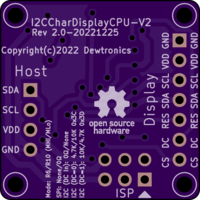I2C Character Display CPU V2
author: dewhisna
2 layer board of 1.00 x 1.00 inches (25.4 x 25.4 mm)
Uploaded:
December 29, 2022
Shared:
December 29, 2022
Total Price:
$5.00
See the new I2C Character Display V3 board for a version with a higher powered MCU and better overall performance.
V2 Update to the Original I2C Character Display CPU Board. This board goes inline between a host CPU and an OLED (or similar) I2C/SPI graphical display. Its purpose is to convert the graphical display into a character-based display, removing the overhead of font rendering and pixel transfer over the slow I2C bus from the host.
Note that the CPU here is the ATmega328PB (PB version) with dual I2C ports. 12 MHz was chosen for the ceramic resonator, instead of 16MHz or 20 MHz, so that it will run at 3.3v within the specs given in the datasheet. You may, however, be able to overclock it successfully, especially if running at 5v. Be careful, however, of OLED displays with very noisy voltage inverters, as they will interfere with CPU overclocking. I managed to brick two ATmega328PB CPUs trying to run one with this board at 20MHz. 16MHz, however, was no problem.
An identical board with a reversed display connector is also available.
V2 Additions/Changes:
Support for SPI communications with the display in addition to I2C
Support for CPU Driven Reset Line to the display
Support for either display driven or CPU driven I2C address (DC pin) option
Ferrite bead on display power to reduce noise from the display’s power inverter
See the new I2C Character Display V3 board for a version with a higher powered MCU and better overall performance.
V2 Update to the Original I2C Character Display CPU Board. This board goes inline between a host CPU and an OLED (or similar) I2C/SPI graphical display. Its purpose is to convert the graphical display into a character-based display, removing the overhead of font rendering and pixel transfer over the slow I2C bus from the host.
Note that the CPU here is the ATmega328PB (PB version) with dual I2C ports. 12 MHz was chosen for the ceramic resonator, instead of 16MHz or 20 MHz, so that it will run at 3.3v within the specs given in the datasheet. You may, however, be able to overclock it successfully, especially if running at 5v. Be careful, however, of OLED displays with very noisy voltage inverters, as they will interfere with CPU overclocking. I managed to brick two ATmega328PB CPUs trying to run one with this board at 20MHz. 16MHz, however, was no problem.
An identical board with a reversed display connector is also available.
V2 Additions/Changes:
Support for SPI communications with the display in addition to I2C
Support for CPU Driven Reset Line to the display
Support for either display driven or CPU driven I2C address (DC pin) option
Ferrite bead on display power to reduce noise from the display’s power inverter

